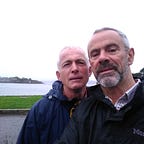Day 26 Rock to Port Isaac . . . .
. . . or rather Port Isaac to Rock. The 8.30 bus from Port Isaac to Rock was cancelled and so we “decided” to walk this walk the other way around.
Port Isaac was just waking up. As we walked through the village the cafes and gift shops were just getting ready for another daily onslaught of visitors.
On leaving Port Isaac it soon becomes clear that this is going to be a hard walk, with lots of steep ascents and descents. The wind is blowing us along and the views of the rocky cliffs and the rough sea make the walking enjoyable.
The cliffs are scarred with evidence of the quarrying which took place a hundred or so years ago. The scenery must have looked very different then; it would have been a hard life for the people working in these dangerous conditions. We however have the opportunity to enjoy the abundant flowers.
We keep walking, hoping the steep ups and downs have come to an end — only to round a corner and find our hope is quashed as we approach another long row of steps . . . . .
At last Doyden Castle (circa 1830) comes into view and so we know we are close to Port Quin. Port Quin in Cornish is Porth Gwynn which means white harbour. It is a welcome sight — because the hardest part of todays 12 mile walk is over!
We enjoy a break at Port Quin and then walk along the grassy cliffs towards “The Rumps” — which have been visible for most of the morning. The walking has become easier.
The path around Trevan Point is steady and we look down on Lundy Hole and what are apparently “nice secluded beaches”. Today we can only see a tumble sharp rocks and crashing waves.
The path now becomes busier as people walk the short circular routes from nearly car parks.
“The Rumps” are getting closer and finally we walk around then headland and then on around Pentire Point with its rocky outcrops, which reminds us of a dinosaur with a spiky back. We have great views of our last walk along the far shore of the Camel Estuary.
Once around Pentire Point we look down into Polzeath. Fortunately it is low tide and we can walk along the shore. We pass rocks encrusted with mussels and then cross the beach to the village. We enjoy our picnic lunch while watching the surfers catching the waves in the far distance.
After lunch we walk out of Polzeath along low grassy cliff edges and beach paths. When we reach Daymer Bay we descend to the beach and walk along the sand. The sandbar is know as the “Doom Bar”. According to folklore it was created as a dying curse by a mermaid who was shot when she refused the advances of a local man.
We then have a choice. We either walk up through the sand dunes or along the sandy beach running beside the estuary. We choose the latter, as it looks a whole lot easier! The tide is very low and as we approach Rock we meet people traipsing across the sand to catch the ferry to Padstow.
We have made good time and find a bakery in Rock. We enjoy coffee and cake and then wait about an hour for the bus back to Port Isaac. It has been a brilliant walk.
